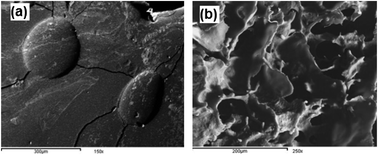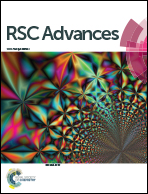Novel nanocomposite hydrogel for wound dressing and other medical applications
Abstract
Graft copolymerization of diallyldimethylammonium chloride (DADMAC) vinyl monomer together with N,N′-methylene-bis-acrylamide (MBA) crosslinking agent onto water soluble carboxymethyl cellulose (CMC) was carried out using ammonium persulfate (APS) initiator. The copolymerization resulted in the formation of hydrogels. The characteristics and properties of these hydrogels were dependent on the conditions affecting the copolymerization reaction and these, in turn, controlled the pore size and porous structure of the hydrogels. Thus, increasing the monomer concentration caused a major enhancement in the swelling ratio of the hydrogel provided that the monomer was used at a concentration of 40% or more. The opposite was true for initiator concentration: the swelling ratio of the hydrogel decreased significantly by increasing APS concentration from 0.05 to 0.25 mol L−1. With respect to MBA crosslinker, a maximum swelling ratio of 30 could be achieved with hydrogel prepared using MBA at a concentration of 0.1 mol L−1; hydrogel prepared in the presence of MBA at 0.05 mol L−1 exhibited zero swelling ratio while hydrogel prepared using MBA at 0.3 mol L−1 displayed a swelling ratio of 10%. The maximum swelling ratio for hydrogel was achieved at pH 7 and a significant decrease in the swelling ratio of hydrogel was observed within the pH range 2–6 as well as at pH 8. The hydrogel could also be successfully attached to modified cotton fabric, namely partially carboxymethylated cotton (PCMC) through ionic crosslinking. The in situ formation of CuO nanoparticles inside the matrix of CMC–DADMAC nanocomposite hydrogel attached to cotton fabric was also investigated and was confirmed using X-ray diffraction and scanning electron microscopy studies. Furthermore, the functional performance of the novel CuO nanocomposite hydrogel as wound dressing was tested for antibacterial activities; the nanocomposite hydrogels demonstrated excellent antibacterial effect. The work was further extended to include the synthesis and characterization of Ag/CMC–DADMAC nanocomposite hydrogel. The latter displayed high antibacterial activity.


 Please wait while we load your content...
Please wait while we load your content...